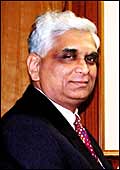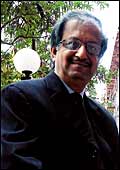|
|
Bharat Doshi
Executive Director (Finance &
Corporate Affairs)
Mahindra & Mahindra |
|
DOSHI'S WINNING MOVES
|
»
Key role in M&M's profits trebling
in two years
»
Improved labour productivity
»
Sold off non-core businesses at the right price
»
Created value for shareholders |
Between
2001 and 2003, on at least three occasions, the lights at Mahindra
& Mahindra's (M&M's) Kandivili unit, deep in suburban
Mumbai, would go out only a few hours before the sun showed up
on the metropolis' horizon. On these nights, the top management
of M&M would get into a huddle by 8 p.m., and begin brainstorming
strategies to improve productivity and reduce cost. Dubbed "The
Midnight Meetings", they would go on till well beyond the
witching hour, with workers also being called in to put forth
their points of view. The Midnight Meetings was just one piece
of the larger game plan christened "Operation Blue Chip",
an exercise aimed at arresting the trend of declining profits
at M&M and assuming leadership positions in each of its businesses,
via innovation, globalisation and efficient financial management.
Whilst it was the top management that collectively blueprinted
that strategy, the onus of implementation rested squarely on the
shoulders of one individual: Bharat Doshi, Executive Director
(Finance & Corporate Affairs).
Doshi delivered. He pulled off a retirement
scheme at the Kandivili plant at a cost of Rs 200 crore, with
a third of the 6,600 workers accepting it. Doshi also succeeded
in improving labour productivity-that is, an increase in production
without adding more workers. Result? Personnel cost as a percentage
of sales came down from 9.47 per cent in 2002 to 7.05 per cent
last year. Get Doshi talking about those days, and he vividly
recollects the midnight meetings, putting a different spin on
it. "It was also an attention drawing device. This helped
to spread the news regarding the seriousness of reducing the cost
and improving efficiency down the line," he explains.
| THE DOSHI DOSSIER |
AGE: 55
QUALIFICATIONS: FCA, FCS, LLM,
PMD (Harvard Business School)
JOINED M&M: In 1973. On the
board since 1992
FAMILY: Wife Vidya a practising
doctor, and daughter Sujata doing her PhD in information security
at the Johns Hopkins University, USA
SHOT IN THE ARM: The four-month
Harvard programme M&M sent him for in the middle of his
career
OTHER DIRECTORSHIPS: Independent
director on board of Godrej Consumer Products, Templeton Trustee
Services, and also on the boards of IIM Calicut and NSE.IT
HOBBIES: Yoga, chess, swimming,
teaching, reading (both fiction and non fiction)
FAVOURITE AUTHORS: J.R.R. Tolkien,
Gabriel Garcia Marquez, Vikram Seth, Arundhati Roy |
Doshi, as you might have gathered by now,
is M&M's Chief Financial Officer (CFO). And, as you might
have also gathered from the goings-on in Kandivili between 2002
and 2003, the role of the automobile company's CFO extends much
beyond accounting, auditing and tallying esoteric numbers and
ratios. As Anand Mahindra, Vice Chairman & Managing Director,
M&M, himself points out: "Bharat Doshi's contribution
to the Mahindra group goes well beyond the conventional role of
a CFO. Through the experience and skills he brings to the job,
he functions in effect as an Assistant Chief Executive."
To be sure, the Scorpio may be the most visible
manifestation of the reversal of fortunes at M&M. But if the
company's profits have more than trebled in two years-from Rs
97 crore in 2002 to Rs 349 crore last year (and Rs 360 crore for
the first nine months of the year ended 31 March 2005)-and if
the share price amply reflects that smart performance (see Creating
Shareholder Value), the relentless efforts of Mahindra's right
hand man can't be ignored. Consider a few of the details of Doshi's
micro-financial management:
 |
"Bharat
Doshi's contribution to the Mahindra group goes well beyond
the conventional role of a CFO. Through the experience and
skills he brings to the job, he functions, in effect, as an
assistant chief executive"
Anand Mahindra
Vice Chairman & Managing Director/ Mahindra &
Mahindra |
Let's begin with working capital. An overall
improvement in supply chain management helped bring down inventory
levels. Then, dealer credit has been transferred to banks via
a tripartite arrangement with the bankers. "The bankers wanted
good customers. They also have the additional comfort that we
are there in the middle (even though the entire risk is borne
by the banks)," says Doshi. This technique has worked well
on the supplier side as well. "Since we are in the middle,
our suppliers got loans at lower rates from the banks and they
in turn passed on a part of that by reducing the price of the
products." Such efforts have resulted in the net working
capital cycle collapsing from 28.49 days in 2001 to a negative
4.15 days by 2004. Doshi predictably isn't satisfied. "There
is still scope for improvement," he says.
Cost control is a common mantra these days,
but cost control in times of highly volatile commodity prices-steel
prices for instance have almost doubled over the past year-is
an art in itself. Doshi for his part believes in "navigating
with zero trauma". Simple translation? Minimise the impact
of the gyrations by entering into long-term contracts with steel
companies. "This has helped us cushion the increase in prices,"
says Doshi.
In a similar vein, the M&M CFO has also
carefully timed his money-raising market visits. Doshi hit the
foreign markets with a foreign currency convertible bond (DCCB)
issue 20 days before the election (after which share prices as
well as the rupee fell against the dollar), that too with a yield
to maturity of just 3.25 per cent (as against the prevailing rate
of around 4 per cent). End result: The FCCB got a conversion premium
of 37 per cent to the then market price. Doshi has made similar
moves in the past as well. "We had incentivised the early
conversion for a one month period (in September 1999) by offering
a slightly lower conversion price, anticipating a sharp fall in
the rupee."
| THE TEAM DOSHI BUILT |
 |
M&M's
Phadke:
Part of Doshi's A-team |
I have an able finance team that
supports me," says bharat doshi. If you think that's
an understatement, hear out the senior-most of his colleagues,
the 54-year-old Uday Y. Phadke, Executive VP (Finance, Accounts
and Legal Affairs), who joined M&M roughly the same time
Doshi did. "I have a nice and long working experience
with Doshi," he says. Clearly, understatements coupled
with longish designations-Phadke is also responsible for the
tax and investor relation functions-are pretty common at M&M's
finance hotshop. Others in the team include S. Venkatraman,
53, Controller of Accounts, who is responsible for the normal
accounting functions like budgeting, MIS, Sebi reporting,
preparation of annual reports and quarterly results. Prabal
Banerji, 48, Treasurer, takes care of all the treasury operations
like banking, investments and forex transactions. S. Durgashankar,
Vice President (Corporate Strategy), is in charge of M&A
activities. V.S. Parthasarathy, 42, Vice President (farm equipment
sector) and Ajay M. Choksey, 52, VP (automotive sector) are
the secondary CFOs for their respective sectors. |
Indeed, after watching Doshi in action, you're
tempted to conclude that nothing is as important to the CFO as
timing. It applies for divestments too. Over the years, M&M
has sold a number of its non-core businesses and holdings, including
a stake in Otis and oil drilling activities. "It's not just
getting out; what's important is getting out at the right price.
And the right time," says Doshi. Last fortnight M&M divested
its stake from its Ford JV, once a strategic investment, which
later became a portfolio holding. The original call to scale back
on the JV was taken when the Scorpio project needed funds. Doshi
should be happy because he's succeeded in recovered his original
investment of Rs 135 crore. Here too, the timing couldn't be better:
Exit Ford, enter Renault.
| "THE CFO SHOULD NEVER BE A NO-MAN" |
 BEST
CAREER MOVE:: "Based on my father's analysis, I decided
to join M&M. So I settled for the Rs 1,000 offer, letting
go of another offer for Rs 1,200" BEST
CAREER MOVE:: "Based on my father's analysis, I decided
to join M&M. So I settled for the Rs 1,000 offer, letting
go of another offer for Rs 1,200"
UNLIKELY TO FORGET: Operation
Blue Chip, involving major restructuring and cost-cutting.
"Out of the 6,600 workers there, 2,200 availed of the VRS
at that time"
UPBEAT ON: M&M Finance. "It will
be playing a strategic role in our growth strategy"
WISDOM, DOSHI-STYLE: "It's not
just about getting out (of non-core businesses), but at the
right price and at the right time"
MOST LIKELY TO BE HEARD SAYING:
"There is still scope for improvement" |
The acid test for the CFO of a conglomerate-don't
forget M&M has interests in automobiles, tractor, auto components,
rural financing, real estate development and information technology-is
when he has to allocate funds between competing businesses. "We
usually provide the seed capital and let them generate the additional
capital," says Doshi. But that doesn't mean he's liberally
doling out the dough. As a thumb rule, he insists that the maximum
break-even level should be 50 per cent of the capacity planned.
That way it will have a high margin of safety and will be able
to make money even if the actual volume is below target (which
typically happens when the industry cycle turns bad). In other
words, cost competitiveness should be such that there is enough
room even at the lower end of the cycle. Each business is accountable
for its strategy and bottom line, even as it operates within the
directions and disciplines set by the corporate centre. "The
unenviable task of maintaining an effective balance between control
and autonomy rests with the CFO. Bharat is outstanding in this
role," says Mahindra.
What often goes unnoticed is the progress
made by subsidiary M&M Finance, which has quietly grown from
30 to 250 branches in the past five years, and which boasts a
balance sheet size of Rs 3,300 crore. "It will be playing
a strategic role in our growth strategy," says Doshi, who
catches up on chess, swimming, teaching and reading when he's
not dictating strategy or making critical decisions. He avers
that "a CFO should never be a 'no' man and must act as a
partner with the operating management-both supportive and productive".
The finance chief swears by team spirit, and his team members
swear by him. Doshi leads a "fun forum", an informal
quarterly meeting of the finance honchos, where they discuss anything
but finance. That should be easy for Doshi. He's the assistant
chief executive after all.
|







 BEST
CAREER MOVE::
BEST
CAREER MOVE::